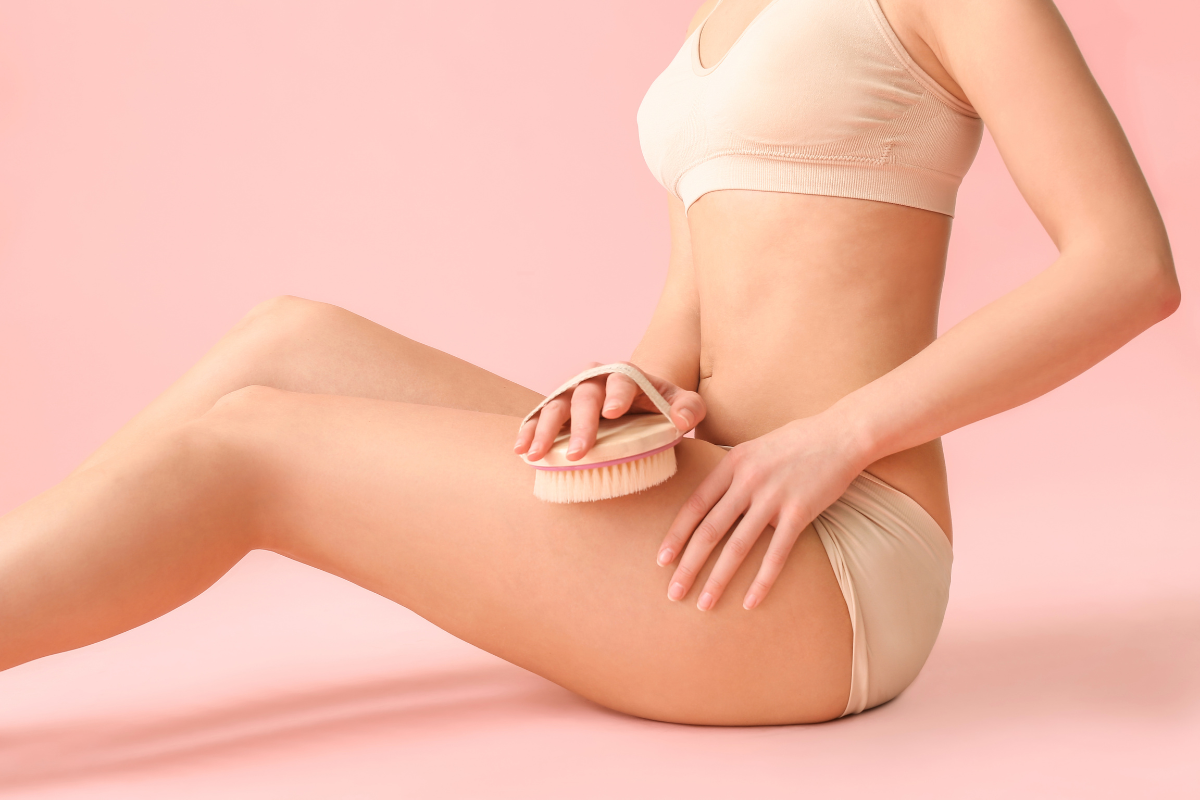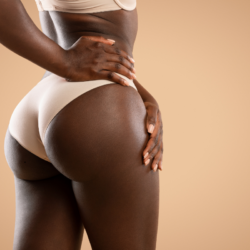There are several types of cellulite: cosmetic cellulite and infectious cellulite (bacterial: staphylococcus or streptococcus).
What is cellulite?
There are several types of cellulite: cosmetic cellulite and infectious cellulite (bacterial: staphylococcus or streptococcus).Infectious cellulite is in fact a bacterial infection caused by staphylococcus or streptococcus. The pathway is a skin infection. The management of this cellulite is essentially medical (antibiotic treatment). It manifests itself in 4 inflammatory points: redness, heat, pain and swelling.
Cosmetic cellulite consists of 3 types:
-
-
- fat or fat, insens itive to pinching is due to excess fat combined with a lack of physical activity
- water y mainly results from poor blood circulation
- Fibrous. or installed cellulite depends on genetic, vascular, hormonal, dietary and nervous factors
-
Cellulite affects 9 out of 10 women and 1 in 50 men at some point in their lives.
Factors that promote cellulite
- Ethnie: Women with dull skin or Asian type is less likely to have cellulite than women with fair complexions for reasons that are still unknown.
- Sex: Cellulite particularly affects women. Women have twice as many fat cells and male fat cells are twice as small.
- Hormones: Cellulite does appear due to hormonal fluctuations and metabolism, which occur at certain periods of life, including puberty, menstrual cycles, pregnancy, heavy weight gain, pre-menopause and menopause. Estrogens, produced in female skin cells from testosterone, and prolactin, increase lipid biosynthesis, the accumulation of fatty acids in adipose tissue and decrease the flexibility of connective tissue. This appearance of cellulite in the form of orange peel is accentuated by oral contraceptives, pregnancy and breastfeeding.
- Heredity: Mothers who have had a long history of cellulite will therefore have girls who are more at risk of developing cellulite as well.
-
Venous insufficiency: Poor venous circulation also promotes water infiltration into adipose tissue and the development of edema
How can I avoid it?
Adapt an anti-cellulite diet: Opt for a fibre diet and finally reduce your intake of salt, carbohydrates (fast sugars) and fats (fat) to avoid causing or worsening cellulite.
- Hydrate a lot, drinking two to three litres of water, herbal teas, sugar-free fruit and vegetable juices
- Wear appropriate clothing and footwe ar: Regular wearing high-heeled shoes and clothing that tightens the legs and calves too much also interfere with good blood circulation and actually promote cellulite.
- Exercise: Sedent ary lifestyle and lack of exercise ultimately promote the development of fat or fat tissue at the expense of muscle mass. On the contrary, sports and exercise increase your heart and respiratory rhythms, thus promoting blood circulation and tissue oxygenation.
- Fighting obesity: Excess weight exacerbates the problem of cellulite.
- Fighting smoking: Nicotine decreases tissue oxygenation
Cellulite and oligotherapy
Oligosol Zinc-Nickel-Co balt interesting as a field modifier as part of slimming regime.
Take 1 bulb a day to take sublingual
Cellulite and homeopathy
In any case
Thuya 5 CH: predominant obesity in the hips, buttocks, lower limbs; cellulite is divided into “horse panties.” Its appearance is usually as a result of taking medication. (Pilule, hormones, psychotropic drugs, antibiotics…) Take for several months once or twice a day.
Natrum sulfuricum 7 CH: the edemas are more generalized, being able to make the sign of the ring in the morning when waking up (the ring gets stuck because the fingers are too swollen). The subject is aggravated by humid weather on a general level and is happy to suffer from rheumatism. To be taken once a day, preferably at bedtime for a few months.
If painful cellulite
Rhus toxicodendron 5CH: Painful cellulite to the touch. Subject aggravated in wet weather.
Phytolacca 5 CH: Painful cellulite, with tendency to obesity and lipomas.
Field treatment
Calcarea carbonica 5 CH: predominant obesity at the root of the limbs, in the stomach and breasts in women. Bulimia to reassure yourself! the subject eats too much, attracted by the heavy things indigestible and without much flavor, milk, dairy, porridge, mashed potatoes, eggs, bread… it will only lose weight if these dairy products are removed. Trend, in addition, to repeated ENT pathologies, as well as digestive disorders (diarrhea), but also to eczema. These individuals are at risk of diabetes.
Gr aphites 5CH: Hormonal deficiency, especially thyroid, is often found in the background. Metabolism is slowed down, with chilliness, tendency to constipation, dry skin that can evolve into eczema, apathy, even depressive syndrome. Cellulite is present, it is hard and sometimes sensitive to pressure.
Pu lsatilla 5CH: in a subject with a sensitive character, variable and changing symptoms. He or especially she is attracted to sweets, sweets, eats for compensation, with a feeling of emotional deficiency. It can’t stand fats, especially animal fats like butter. This medication is very commonly indicated in adolescence. In this area, it is mainly carbohydrates that are responsible for the overweight
Cellulite and herbal medicine
Diuretic plants
Piloselle mother dye: This plant can be a very interesting supplement in the management of cellulite, by its essentially draining and stimulating effect on the kidney.
Lipolytic plants
Caffeine plants
Guarana and cocoa (rich in caffeine). Ivy and seaweed extract, prêle, clematis…
Caffeine increases levels of AMPC, a coenzyme activator of triglycerides lipase. However, orally, caffeine has a modest lipolytic effect in the peripheral tissues and causes many adverse effects on the central nervous system (nervousness, restlessness, sleep disturbances…). Therefore, it is best to use these plants in the form of gel, creams or preparations for external use.
Plants limiting lipogenesis
Sacred Lotus, Yacon and Vine of Peru
Defibring plants
Daisy oil tones blood vessels and firms the skin. Use in circular massages on cellulite areas
- Plants acting on connective tissue: Pinea pple (A n anas Arkogélules), papaya
- Grape marc (M incigrap Arkogélules): By improving hair and venous circulation, these compounds effectively combat venous stasis, which causes the pernicious installation of cellulite and promotes blood purification.
The synergy of these actions (drainage and improved circulation) reduces cellulite by releasing fat clumps trapped in collagen fibers.
Natural anti-cellulite gel
Mother dye cream TM Vitis vifera 10ml, TM Fucus vesiculosus 10 ml, TM Hedera helix 10 ml, Excipient qsp 100g. Apply in ascending circular motions 2/day until desired results are achieved.
Cellulite and gemotherapy
Gemotherapy is useful for treating cellulite in particular by its action on venous circulation: helps eliminate water retention, reduce overweight, and improves circulation. It relieves heavy legs and quickly improves swollen feet and legs.
Glycerinate macerate of chestnut buds and glycerinate macerate of juniper buds. 50 to 100 dse/d in glycerinated macerate 1 D
Cellulite and aromatherapy
Dry rubbing the thighs with a hair glove to cause better dilation of the blood capillaries and actually promote the penetration of the massage oil mixture or massage gel. Apply in ascending circular massages to promote lymphatic drainage on the areas to be treated (hips, buttocks…)
Uninfiltrating massage oil
Grapefru it 80 drops
Le mon 40 drops
Cypr ess 20 drops
Cedarwo od: 20 drops
Apricot kernel oil QSP 30ml
Mix before application. Apply in the evening before bedtime in circular massages by raising from the ankles to the thighs for 15 days to a month
Be careful not to expose yourself to the sun for the next 3 hours (risk of photosensitization)
Anti-cellulite massage gel
- Junipe r: 1ml
- Clare sage: 3ml
- Mint: 1ml
- Cypress 1ml
- Lavende r: 3ml
-
Neutral gel for Qsp 100g essent ial oils
Apply in the evening before bedtime in circular massages by raising from the ankles to the thighs for 15 days to a month.
Be careful not to expose yourself to the sun for the next 3 hours (risk of photosensitization)
Ready-to-use
- Massage oils
Weleda Slimming Massage Oil: Apricot Kernel Oil, Jojoba Oil, Wheat Germ Oil, Essential Oils Including Cedar, Cypress and Lemon, Birch Leaf Extract, Small Holly Root Extract, Rosemary Leaf Extract
Pure essential thinning d ry oil: The 18 Essential Oils of this dry oil have lipolytic, disinfiltrating subcutaneous tissues and microcirculation stimulants. They tone the skin, fight water retention and fight pimples.
Pharmacy Tip: When to consult a doctor
In case of infectious cellulite: Necrotizing cellulite begins with a very painful red swelling, which becomes purple and then black as the tissues die.These cellulites are fatal in about 10% of cases. In the end, they cause one in two of the after-effects and scars that are consistent and permanent.





